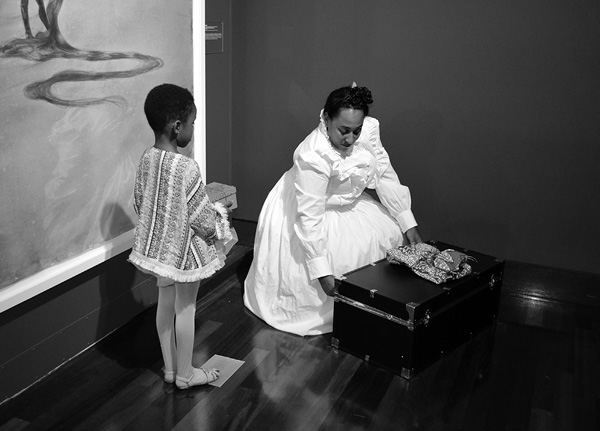
ADORNMENT
first performed on October 19, 2016
Spelman College Museum of Fine Art, Atlanta, GA
performed once in 2016
JESSICA SCOTT-FELDER
Atlanta, GA / Spartanburg, SC / Charleston, SC
jessicascottfelder.com
ADORNMENT
JESSICA SCOTT-FELDER
Inspired by the standards of beauty from the early 1920s to the 1960s, I performed a site-specific work based on early student catalogs from Spelman College Archives. In the 1921 Spelman Seminary Catalog, the required wardrobe was specified for incoming students: two white cotton waists (corsets), several dark cotton dress skirts, and one white dress. All of the items were to be brought to campus in a trunk for the hall matron’s approval. In response to this historical standard of dress and beauty, I performed an interactive ritual titled “Adornment,” during which audience members were invited to dress me in several of the aforementioned garments.
I was accompanied by a live string quartet for the duration of the fifty-minute performance. Each musical selection referenced aspects of college life as a Spelman student and historically significant aspects of African-American life between the 1920s and 1960s. For example, the Harlem Renaissance was represented by the Duke Ellington composition “In a Sentimental Mood.” The art for a current exhibition and music also inspired my movements in speed and mood.
Dressed in a nude-colored unitard and corset, I began “Adornment” by entering the Spelman College Museum of Fine Art carrying a 50-lb trunk on one shoulder for seven minutes. I walked around the museum pausing at six changing stations placed throughout. Each station represented a garment that would be placed by an audience member in the room: white corset, white petticoat, black shoes, black socks, white dress, hair, and jewelry. The most challenging garment for the audience to place on me was the second white corset—I wanted it tight in order to maintain the coveted coke bottle silhouette.
Dressing oneself is often a mundane ritual; however, I found that having to be dressed by others, and, from the audience’s perspective, having to dress another body placed an unintended sense of responsibility on both participants. Several audience members were eager to dress me; others expressed reluctance, embarrassment, and fear. Towards the end of “Adornment,” I came to the realization that the longer I invited others to dress me, the more the audience members became performers—the desire to have a role in the transformation from formless figure to womanly presence was a mutual goal.